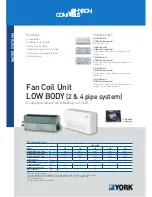
11
PUMP:
GENERAL SAFETY – PUMP
1. An operating pump, with a blocked discharge, will
heat the water and pump housing. Allow pumps to cool
before handling.
2. High temperature sensors can help protect plastic plumbing
from disfiguring and/or expanding.
3. Running a pump without water may cause damage to
the seal.
GENERAL OPERATION – PUMP
1. Locate the pump as close to the water source as is practical.
2. Total suction lift (vertical lift plus any friction loss in suction
line) should not exceed 10’ for optimal performance. Suc
tion lift of 15’ is attainable depending on elevation, water
temperature, and atmospheric condition. Pump performance
is affected when suction lift exceeds 15’.
3. Fill the pump case and suction pipe with water to expel as
much air as possible prior to start-up. Running a pump dry
may cause damage to the seal and void warranty.
4. Pump and pipe must be drained if there is any danger
of freezing.
PIPE CONNECTION
1. Plastic or galvanized steel pipe are most commonly used.
Support pipe as needed.
2. Keep suction and discharge lines as large as possible. Pipe
should not be smaller than the corresponding suction
and discharge holes.
3. Avoid excess fittings when possible. Use straight runs when
possible.
4. All joints and connections should have pipe-specific sealing
compound applied and be completely tightened.
5. Isolation valves or unions on suction and discharge allow
for easy pump removal with multi-pump or positive inlet
pressure applications.
6. Suction pipe should never have a higher elevation than
the pump.
OPERATION:
INITIAL PRIMING
1. Remove one priming plug from pump housing and fill the
pump body and suction line completely with water.
2. Normal system start-up will take a few minutes for air to
expel from system and water to begin to cycle – depending
on suction lift. If no water is flowing after a few minutes, turn
the pump off and refer to troubleshooting guide (p.8). Do
NOT run pump dry for any period of time.
3. Unit must be full of liquid before operating. Never run dry.
Running a pump dry may cause damage to the seal and void
the warranty.
4. Do not run against a closed discharge for more than a
few minutes.
ROTATION
1. Single phase motors are pre-wired for CCW, as viewed from
suction tapping, and should never be reversed.
2. Three phase motors must be verified at job site.
MAINTENANCE – LUBRICATION
1. No lubrication is required. The ball bearings are
permanently lubricated and sealed at the factory.
MAINTENANCE – FREEZING
1. Drain the entire system if there is a danger of freezing.
2. Drain plugs are provided in both upper and lower pump
case chambers.
3. Filling the pump with non-toxic Munro Freeze Defeat and
replacing the plugs, will reduce the oxidation in the case over
the winter. Before spring start-up, drain the Munro Freeze
Defeat from the case.
RECOMMENDED OPTIONAL EQUIPMENT:
1. Strainer – Use of strainers prevent large debris from entering
pump system through suction line.
2. Pressure Gauge – Use of a pressure gauge helps to
troubleshoot and identify a pump or system issue.
3. Discharge Valve – Use of a gate or ball valve on the
discharge side of a pump allows pump isolation for removal.
4. Foot Valve – Use of a foot valve (or check valve) can aide
the priming of a centrifugal pump. If suction lines are kept
full, the pump does not have to evacuate the air before
pumping water.
ROTARY SEAL ASSEMBLY REPLACEMENT:
Make certain the power supply is disconnected
before attempting to service the unit!
SEAL REMOVAL
1. Remove the case bolts and separate pump case from
motor assembly.
2. Remove diffuser bolts and diffuser from motor assembly.
3. Insert an open-end 9/16” (LP075B, LP100B, LP150B, LP200B,
LP300B) or a 5/8” (LP1502B) wrench into the side of the
mounting ring, slowly turning the impeller until the wrench
seats itself onto the flats of the shaft. Once properly seated,
the wrench will keep the shaft from turning. LP3005B model
uses keyed shaft and sleeve. Removal of these impellers
may require high heat to remove the shaft sleeves.
4. Expose the seal assembly by spinning the impeller
counter-clockwise to unthread it from the motor shaft.
5. The seal spring will release as the impeller is removed.
6. Being careful not to damage the motor shaft, remove the seal
head, seat and rubber from the seal pocket. The use of a
screwdriver or similar tool may be necessary.
7. Should the seal be difficult to remove, the mounting ring
can be completely removed for easier access by taking out
the mount ring bolts.
8. Once the seal is removed, clean the pocket removing all
debris.
The rotary seal assembly must be handled
carefully to avoid damaging the precision lapped faces of the
sealing components.
SEAL INSTALLATION
NOTICE: It is recommended to only install new seals. Do not
install used or dirty seals.
NOTICE: Application of a light coat of multi-purpose chassis
grease to the outer diameter of the rubber gasket may make
installation easier. Be certain the seat is kept clean and free of
dirt and/or grease at all times.
1. Insert the seal seat rubber gasket into the recessed area
of the mount ring.
2. Slip the seal head assembly onto the motor shaft.
3. Using uniform pressure, be sure the seal’s seat or mounting
ring has completely bottomed-out in recessed area.
4. After placing the spring, install the impeller and bolt the
diffuser onto the motor assembly.
5. Replace and bolt the pump body to the motor assembly.
Call Munro technical support for any questions relating to
start-up or operation of this pump.
Toll Free: 1.800.942.4270
Munro LP Series Pump
OPERATION & MAINTENANCE










































